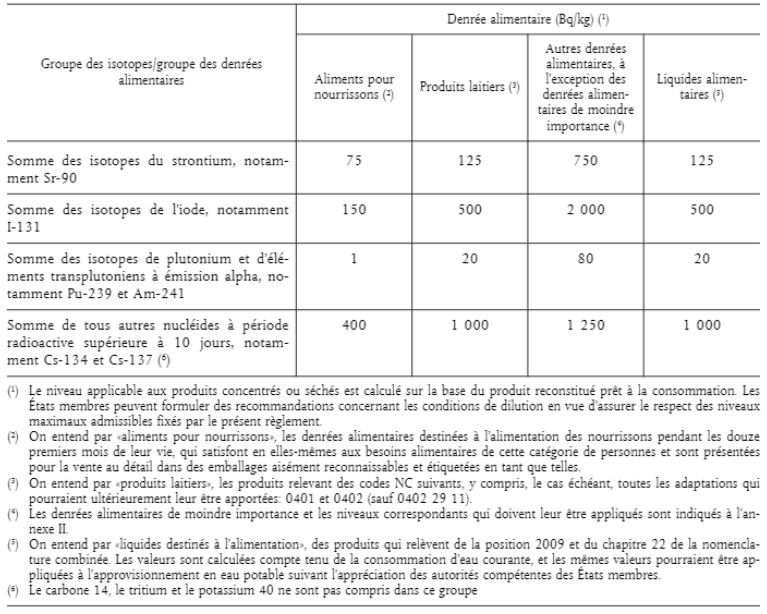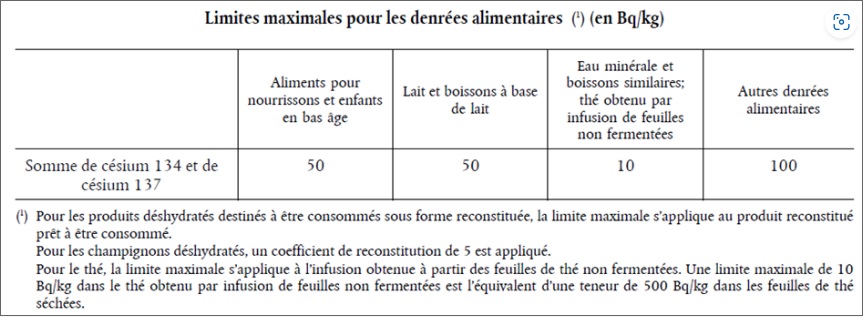Foodstuff controls
Radiation monitoring in foodstuffs producted in France or imported for distribution
DGAL (Directorate General on Food Safety) implements the products controls (french or imported) with food sample campaigns, named monitoring plans and control plans (PSPC in french). Based on random samples, representing the production and consumption, the monitoring plans will assess the overall exposure of consumers related to a specific risk, and then, identify the required treatment measures to limit this risk. In particular, they include the radiological risk control on the search for radionuclides in french or imported producted foodstuffs.
Surveillance of foreign foods: maximum admissible levels (MAL)
The control of the foodstuffs in emergency situations is based on compliance with radioactivity limitsthe maximum admissible levels (MAL). These levels are defined by Euratom Regulation 2016/52 on a reference level of 1mSv per year for the increase in the individual effective dose by ingestion, and on an assumption of the contamination, at the level of the MAL, of 10% of foodstuffs of the year (excluding infants). These MAL are organized into 4 "families", and expressed in Bq/kg of food. In the event of a nuclear accident, a regulation sets the radioactivity levels to be respected for the importation of any food into the European Union - such regulations were adopted following the Chernobyl and Fukushima accidents

On a practical level, the majority of analyzes are related to the search of cesiums (134Cs, 137Cs), and iodines (131I, …), carried out by gamma spectrometry. This method has the advantage of being able to characterize all gamma-emitting radionuclides, whether they are artificial or natural, such as potassium 40 (40K). The results show that potassium 40 has activities of the order of a hunded Bq/kg fresh food, i.e. the highest activities of all radionuclidesoutside of any local human influcence. As for other natural radionuclides, it is not subject to MAL because its impact on health is considered as negligible.
Results obtained for radionuclides of artificial origin mainly highlight the presence of cesium 137, at levels reaching up 300Bq/kg, lower than the applicable MAL (1250 Bq/kg).
Chernobyl et Fukushima
Following the accident in the nuclear power plant of Chernobyl, on 26 April 1986, a significant amount of radioactive elements were spread in the atmosphere, and quite a number of third countries were impacted (outside European Union). Hence, European Commission has adopted successively, since 1986, several arrangements to define the conditions for the import of foodstuffs in European Union, the last being the 2020/1158 lesgislation on 5 August 2020 modified by the 2024/256 legislation of 17 January 2024.
Some products, from third countries impacted by the nuclear accident of Chernobyl, still present a pollution level by radioactive cesium higher than the maximum cumulative tolerance of radioactive pollution. Observations of last years provide convincing results, indicating that the Cs137 contamination level, as a result of the accident, remains high for a number of products from species living and growing in the forests and wooded areas around the site. This is a consequence the persistence of Cs137 with hig levels of contamination in this ecosystem, due to its half-life, which is 30 years. Radionuclide Cs134, with a half-life of 2 years, is considered as totally disintegrated since the Chernobylaccident.
Such levels of pollution, representing potentially a risk for public health, lead to monitor the radioactive contamination level of foodstuffs from third countries impacted by the nuclear accident, and to exclude the non-compliant products from European Union market.
Government services must proceed to the control of foodstuff lots, imported from third countries, according to the 2020/1158 lesgislation modified by the 2024/256 legislation of European Commission, on 17 January 2024, relative to the conditions for the import of human and animals foodstuffs from third countries in European Union following the accident. The mechanism of control is part of legal framework of the 2017/625 legislation, on 15 March 2017, about official controls, also named OCR rules (Official Controls Regulation).
Regulation 2020/1158 amended by Regulation 2024/256 provides for the carrying out of documentary checks on all shipments received at the border control posts (PCF), identity and physical checks at a frequency of 20%. Taking into account the expereience linked to current controls and the low number of cases of exceeding the maximum tolerances, the documentary controls concern all shipments of mushrooms, with the expection of cultivated mushrooms, and of cranberries, blueberries, and other wild fruits and derived products of the genus Vaccinium.
Products must respect the maximum cumulative tolerance for radioactive contamination by 137Cs :
- 370 Bq/kg for milk and dairy products, and for foods for infants and young children
- 600 Bq/kg for all other concerned products
The accident at the Fukushima nuclear powerplant on March 11, 2011, caused the release into the atmosphere of numerous radionuclides, contamining the environment and in particular, certain foodstuffs. Levels of radionuclides on certain food products originating in Japan were found to exceed the action thresholds in force in Japan for foodstuffs. Since such contamination could constitute a risk for public health and animal health in the European Union, the European Commission, as following the Chernobyl accident, wished to define specific conditions for the importation of foodstuffs and animal feed originating in or coming from Japan. For the sake of consistency, and to facilitate the application of the regulations, the maximum limits, defined by the Implementing Regulation 2016/6 of the European Commission of January 5, 2016, have been aligned with the values established by the Japanese lesgislation in force.
States services must therefore carry out checks befores releasing batches of foodstuffs imported from Japan into free circulation, and exclude from the market any foodstuffs which present non-compliant levels of radioactive contamination.
Shipments of products are subject to official controls upon entry into the Union, at border control posts (PCF). In addition to documentary checks on all consignments, the competent authorities at the PCF carry out random identity and physical checks, including laboratory analyzes for the presence of 134Cs and 137Cs.


Download
Results of radiological controls on imported foodstuffs, grouped by year:
Download the 2025 controls data on imported foodstuff - Before June 2025
Download the 2024 controls data on imported foodstuff
Download the 2023 controls data on imported foodstuff
Download the 2022 controls data on imported foodstuff
Download the 2021 controls data on imported foodstuff
Download the 2020 controls data on imported foodstuff
Download the 2019 controls data on imported foodstuff
Results of radiological controls, done by DGCCRF and DGAL (imported foodstuffs or not):
 return to top
return to top




